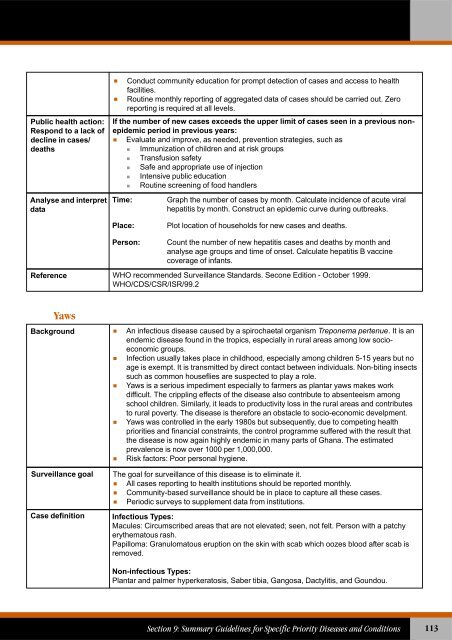Technical Guidelines for Integrated Disease Surveillance ... - PHRplus
Technical Guidelines for Integrated Disease Surveillance ... - PHRplus
Technical Guidelines for Integrated Disease Surveillance ... - PHRplus
Create successful ePaper yourself
Turn your PDF publications into a flip-book with our unique Google optimized e-Paper software.
Public health action:Respond to a lack ofdecline in cases/deathsAnalyse and interpretdataConduct community education <strong>for</strong> prompt detection of cases and access to healthfacilities.Routine monthly reporting of aggregated data of cases should be carried out. Zeroreporting is required at all levels.If the number of new cases exceeds the upper limit of cases seen in a previous nonepidemicperiod in previous years: Evaluate and improve, as needed, prevention strategies, such as Immunization of children and at risk groups Transfusion safety Safe and appropriate use of injection Intensive public education Routine screening of food handlersTime:Graph the number of cases by month. Calculate incidence of acute viralhepatitis by month. Construct an epidemic curve during outbreaks.Place:Plot location of households <strong>for</strong> new cases and deaths.Person:Count the number of new hepatitis cases and deaths by month andanalyse age groups and time of onset. Calculate hepatitis B vaccinecoverage of infants.Reference WHO recommended <strong>Surveillance</strong> Standards. Secone Edition - October 1999.WHO/CDS/CSR/ISR/99.2YawsBackground An infectious disease caused by a spirochaetal organism Treponema pertenue. It is anendemic disease found in the tropics, especially in rural areas among low socioeconomicgroups. Infection usually takes place in childhood, especially among children 5-15 years but noage is exempt. It is transmitted by direct contact between individuals. Non-biting insectssuch as common houseflies are suspected to play a role. Yaws is a serious impediment especially to farmers as plantar yaws makes workdifficult. The crippling effects of the disease also contribute to absenteeism amongschool children. Similarly, it leads to productivity loss in the rural areas and contributesto rural poverty. The disease is there<strong>for</strong>e an obstacle to socio-economic develpment. Yaws was controlled in the early 1980s but subsequently, due to competing healthpriorities and financial constraints, the control programme suffered with the result thatthe disease is now again highly endemic in many parts of Ghana. The estimatedprevalence is now over 1000 per 1,000,000.Risk factors: Poor personal hygiene.<strong>Surveillance</strong> goalCase definitionThe goal <strong>for</strong> surveillance of this disease is to eliminate it. All cases reporting to health institutions should be reported monthly. Community-based surveillance should be in place to capture all these cases.Periodic surveys to supplement data from institutions.Infectious Types:Macules: Circumscribed areas that are not elevated; seen, not felt. Person with a patchyerythematous rash.Papilloma: Granulomatous eruption on the skin with scab which oozes blood after scab isremoved.Non-infectious Types:Plantar and palmer hyperkeratosis, Saber tibia, Gangosa, Dactylitis, and Goundou.Section 9: Summary <strong>Guidelines</strong> <strong>for</strong> Specific Priority <strong>Disease</strong>s and Conditions113















